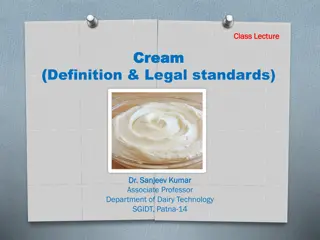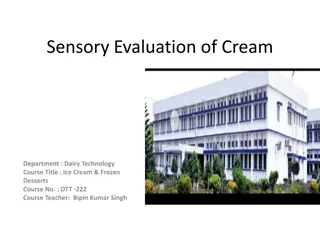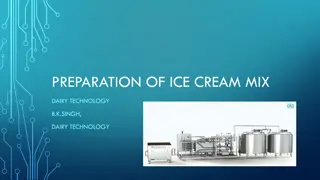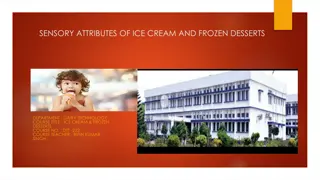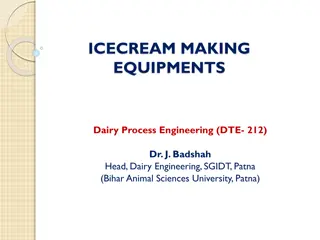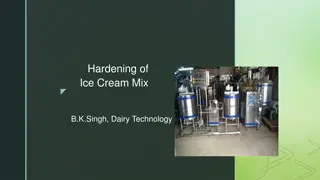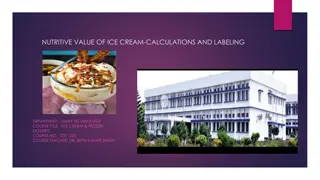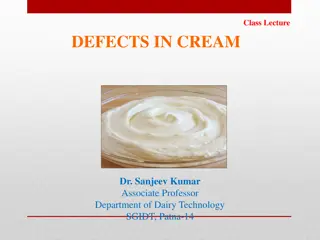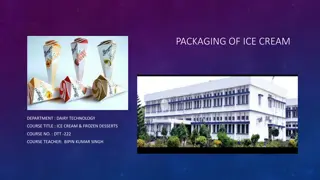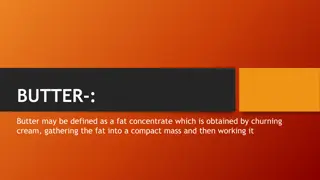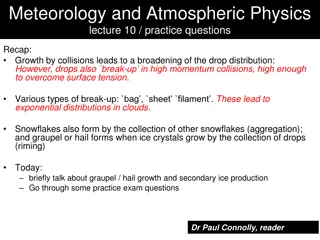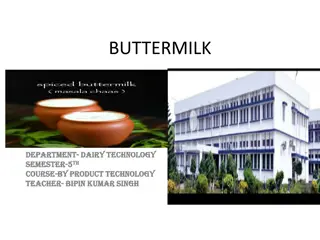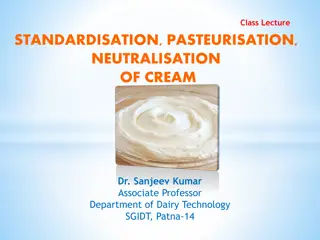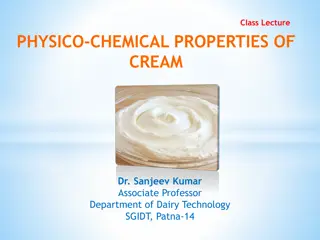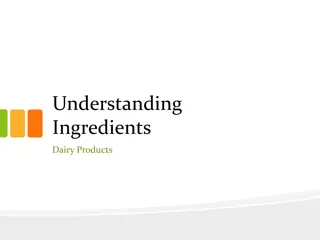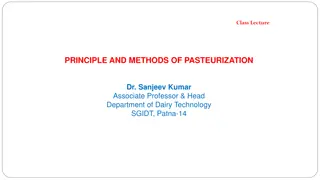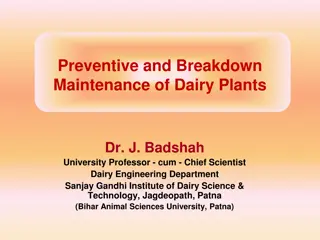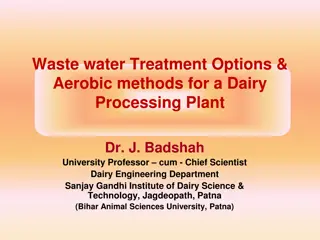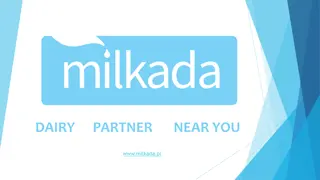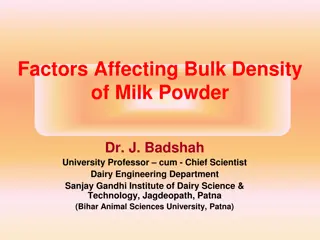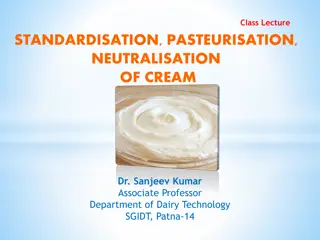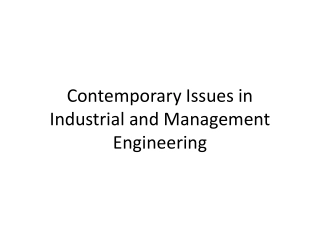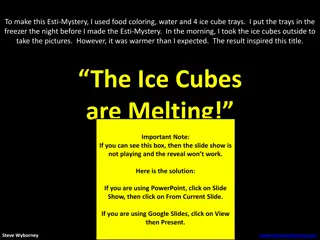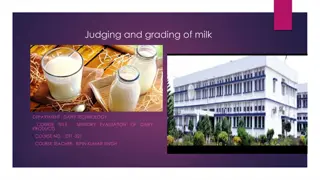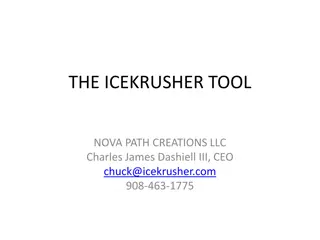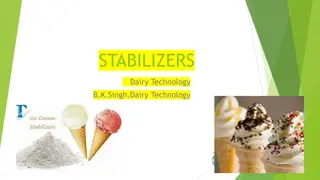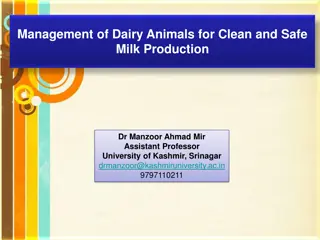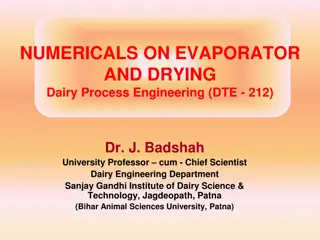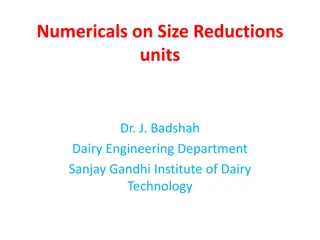Dried Ice Cream Mix in Dairy Technology: Advancements and Manufacturing Process
Ice cream manufacturing faces challenges during lean seasons due to milk shortages. Dried ice cream mix powder offers a solution with benefits like reduced storage space, ease of packaging, and lower transportation costs. The composition includes milk fat, protein, sucrose, stabilizers, and emulsifiers. The manufacturing process involves metering liquid and powdered ingredients, pasteurization, homogenizing, aging, and freezing. However, challenges arise in mixing powders into liquids due to particle agglomeration and cohesive powders like SMP and cocoa. Special handling and processing are needed for stabilizing and emulsifying agents to achieve a satisfactory consistency.
Download Presentation

Please find below an Image/Link to download the presentation.
The content on the website is provided AS IS for your information and personal use only. It may not be sold, licensed, or shared on other websites without obtaining consent from the author. Download presentation by click this link. If you encounter any issues during the download, it is possible that the publisher has removed the file from their server.
E N D
Presentation Transcript
DRIED ICE CREAM MIX Department : Dairy T echnology Course Title : Ice Cream & Frozen Desserts Course No. : DTT -222 Semester-4th Course T eacher: Dr . Bipin Kumar Singh
Introduction Ice cream is a delicious, wholesome,frozen dairy product and is liked equally by the people of all age groups. Ice cream is obtained with the addition of milk, cream, sugar in certain proportions and freezing. During lean season, there is a acute shortage of milk and milk products. Significant advancements in drying techniques have overcome this difficulty by manufacturing ice cream mix powder during flush season and using it during lean season for the ice cream manufacture. The advantages claimed for dried ice cream mix are reduction in volume with a consequent saving in storage space, ease of packaging ability,refrigerated storage space not necessary and lower transportation costs due to reduction in weight. and handling, lesser perish
Composition of Dried Ice Cream Mix SNO. Constituents Percentage% 1 Moisture(Max.) 4.0 2 Milk Fat(Max) 27.0 3 Milk Protein(Max) 9.5 4 Sucrose(Max) 40.0 5 Stabiliser & Emulsifier(Max) 1.25
Manufacture of Dried Ice Cream Mix A typical mix would be prepared in the following manner: Liquid ingredients are weighed/metered into the process vessel. Heating follows to aid melting of the fat and dissolving/hydration of subsequent ingredients. Powdered ingredients - skim milk powder, sugars, whey powder, etc. are added to the liquid and mixed until dispersed. Stabilizing and emulsifying agents are added. These may be dry premixed with other ingredients, (e.g. sugar) to reduce particle agglomeration and weight the powder to aid incorporation into the liquid. Fat is added. Butter or other solid fats may be melted in a separate vessel before addition to the mix. The mix is pasteurized at around 185 F (85 C). The mix is homogenized, usually by passing through a high pressure homogenizer. The product is then aged in a holding (or ripening) tank to allow the stabilizing agents to hydrate and the fat to crystallize. Flavor and coloring may be added at this stage. The finished mix is frozen in special freezers which whip a controlled amount of air into the mix.
The Problem Mixing powdersinto liquids is one of the most difficult mixing operations.The process is subject to a number of problems when using conventional powder/liquid wetting systemsandagitators: Powder mustbe addedatacontrolled rate toreduce agglomeration of particles. Premixing of powders increases labor costsandprocess time. SMP, whey powder and cocoa powder (used in chocolate ice creams) are very cohesive, making handling andcontrolled powder addition difficult. Stabilizing and emulsifying agents have an even greater tendency to agglomerate andrequire special handling. Conventional systemsdonot produce sufficient shear tobreak down agglomerates. Long processing times are required to complete dispersion and achieve a satisfactory consistency. Cocoa (where used) needs to be thoroughly wetted and cooked to prevent it imparting a gritty or floury texture tothe ice cream.
The Solution Stage 1 The high speed rotation of the rotor blades creates a powerful suction which draws the liquid and solid/powdered ingredients into the workhead.These can be added without theneedfor pre-mixing. Stage 2 The materials are subjected to intense shear in the confined area of the workhead. Agglomerates are broken down in the gap between the rotor blades and stator wall.
Contd.. Stage 3 A lump-free mixture is rapidly obtained. The product is forced out of the stator as fresh material is drawn into the workhead. A circulatory mixing cycle develops in which all the material passes through the workhead.
The Advantages Premixing of powdered ingredients is not necessary. Agglomerate-free mix. Stable emulsion. Rapid mixing times. Maximized yield of raw materials as thickening agents are fully hydrated and other ingredients are properly dispersed. Uses: It isconvenient touseas a valueaddedproduct. Softserveicecreammanufacturers havea greatutility ofthisproduct.
LIQUID VS. POWDER ICE CREAM MIX LIQUID ICECREAM MIX THE PRODUCT - Liquid ice cream mix creates the quintessential soft serve ice cream, the type of product you remember eating as a child. The taste and texture are similar to that of the large chains that carry soft serve, like Dairy Queen. In more technical terms, liquid ice cream mix is dairy-based and the butterfat content is higher (4-6%),creatinga smoothericecream with fewer ice crystals. DISTRIBUTION,STORAGE & PRICE - Liquid ice cream mix must be kept refrigerated below 40 and has a short shelf life, requiring rapid distribution and quick use. Not every distributor has the ability to distribute liquid mix, due to its short shelflife.Therefore, liquidsoftserve mixisnot available everywhere. These requirements make transporting this kind of ice cream difficult, putting a strain on distribution and transportation on all levels. Thus, liquid mix is recommended for shops, restaurants, and those making icecream on-siteand where the distributionof the liquidmix isavailable. Liquid ice cream mix will run you a few more dollars than powder, due to the higher fat content. Fat equalsmoney, inthiscase, and higherfat content means a more expensive product.
Contd POWDER ICECREAM MIX THE PRODUCT - Did you ever eat ice cream at the county fair as a kid? You probably enjoyed ice cream made from powder mix then! Powder ice cream mix is usually nondairy. Compared toliquid mix, powderice cream mixhas alittle bit more crystallization. DISTRIBUTION, STORAGE & PRICE - Powder mix has a stable shelf life and is easily transportable, making it effective and efficient for distribution. These features allow the mix to be shipped anywhere, making powder mixconvenient for those without liquid mix distribution. Easy transportation also allows the customer to make ice cream virtually anytime and anywhere - ice cream machine andelectricity withstanding. For these reasons, powder mix is great for fairs and festivals or for any seller that needs to travel with their product. Powder mix will also cost you less, due to a lack of fat in the mix.And that'saplus for everyone!
Benefits of Dry Mixes Free recipe support Simple to use Hydrate with milk Long Shelf Life Low Shipping Costs Cost Effective Easy to Store No refrigeration required


